The AMD Radeon RX 5500 XT Review, Feat. Sapphire Pulse: Navi For 1080p
by Ryan Smith on December 12, 2019 9:00 AM ESTPower, Temperature, & Noise
Last, but not least of course, is our look at power, temperatures, and noise levels. While a high performing card is good in its own right, an excellent card can deliver great performance while also keeping power consumption and the resulting noise levels in check.
| Radeon Video Card Voltages | |||||
| 5700 Max | 5500 XT Max | 5700 Idle | 5500 XT Idle | ||
| 1.025v | 1.141v | 0.775v | 0.700v | ||
Back when the RX 5700 series launched, AMD’s voltages surprised me; the RX 5700 XT went as high as 1.2v on TSMC’s 7nm process. For better or worse, it looks like those voltages aren’t a fluke, as we see high voltages with the RX 5500 XT as well. In this case the card tops out at 1.141v, a not insubstantial decrease from the RX 5700 XT, though it’s still relatively high. AMD’s GPUs are still the only high-throughput GPU-like product we’ve seen voltages for on this process, so it’s hard to say whether this is a TSMC thing or an AMD thing. But either way, as AMD’s own voltage/frequency curve helpfully illustrates, the last couple of hundred MHz on the RX 5500 XT gets to be quite expensive in terms of power.
| Radeon Video Card Average Clockspeeds (Rounded to the Nearest 10MHz) |
|||
| Game | 5500 XT | 5700 | |
| Max Boost Clock | 1860MHz | 1750MHz | |
| Official Game Clock | 1717MHz | 1625MHz | |
| Tomb Raider | 1810MHz | 1680MHz | |
| F1 2019 | 1810MHz | 1650MHz | |
| Assassin's Creed | 1750MHz | 1700MHz | |
| Metro Exodus | 1800MHz | 1640MHz | |
| Strange Brigade | 1840MHz | 1660MHz | |
| Total War: TK | 1840MHz | 1690MHz | |
| The Division 2 | 1800MHz | 1630MHz | |
| Grand Theft Auto V | 1830MHz | 1690MHz | |
| Forza Horizon 4 | 1830MHz | 1700MHz | |
Despite that power cost, however, the RX 5500 XT manages to keep its clockspeeds rather high. Even without Sapphire’s higher power cap performance BIOS, their 8GB card is frequently at 1800MHz or better, putting it well ahead of AMD’s official game clock of 1717MHz. This means the card is running fairly close to its clockspeed limit – so Sapphire’s extra power doesn’t do a whole lot – but it also means the card is doing all of this on 130W (or less) of power.
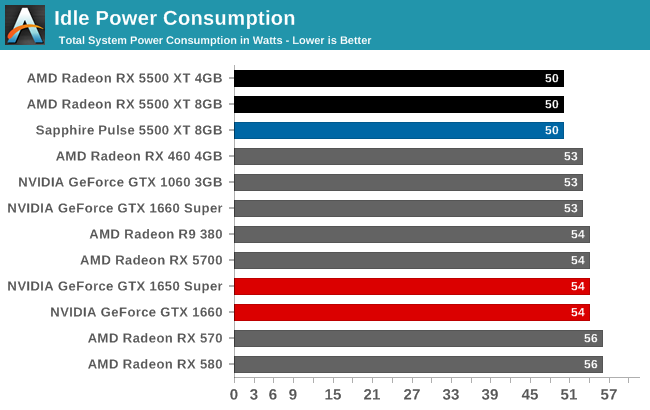
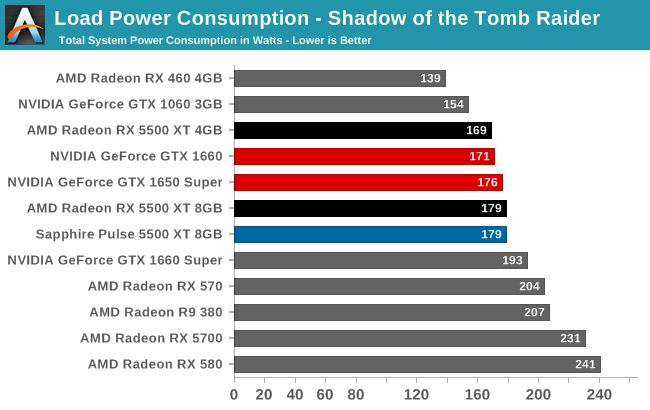
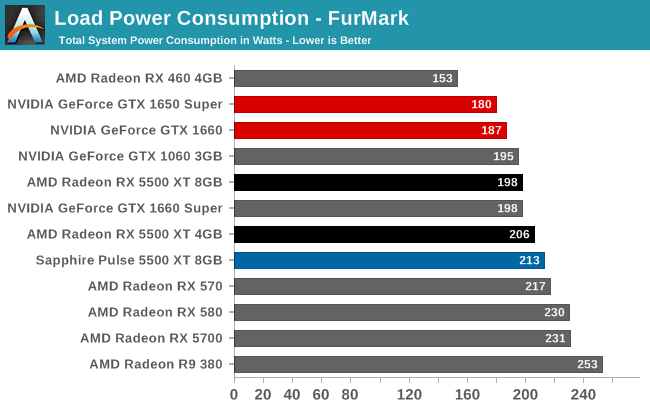
With the combination of TSMC’s 7nm process, AMD’s firmware optimizations, and I suspect the use of just 8 PCIe lanes, the RX 5500 XT fares very well when it comes to idle power. At 50W for the entire system, this is lower than any other configuration by a few watts. Which for idling, where power consumption is already low, is huge. No wonder Sapphire is able to offer zero fan speed idle here; the card is burning very little power at idle.
Similarly, load power is looking fairly good as well. Under Tomb Raider, the total system power consumption with the AMD cards is highly competitive with the NVIDIA competition (though as we’ve seen, actual game framerates trail a bit). Though AMD does fall behind under FurMark, as the 130W+ RX 5500 XT cards all have higher TDPs than NVIDIA’s 120W/125W equivalents, and FurMark will drive all of these cards to their power limits.
In practice, all of this generally reflects the cards’ relative specifications. The RX 5500 XT is able to hang with the somewhat inefficient GTX 1650 Super, however once we get to the more efficient GTX 1660, NVIDIA is consuming less power while delivering better performance.
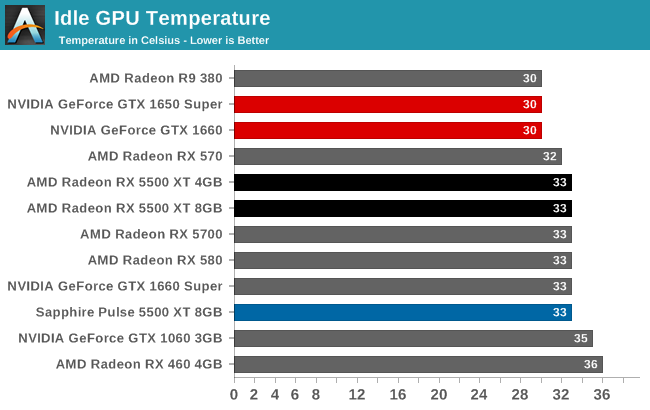


Early on I mentioned that Sapphire’s Pulse cards might be a bit overbuilt, and now that we’re getting into temperature and noise measurements, we get to see why. The idle GPU temperatures are what we’d expect for a zero fan speed idle card; meanwhile the load temperatures don’t crack 70C under Tomb Raider, and even FurMark only pushes the worst card to a well within tolerances 76C.
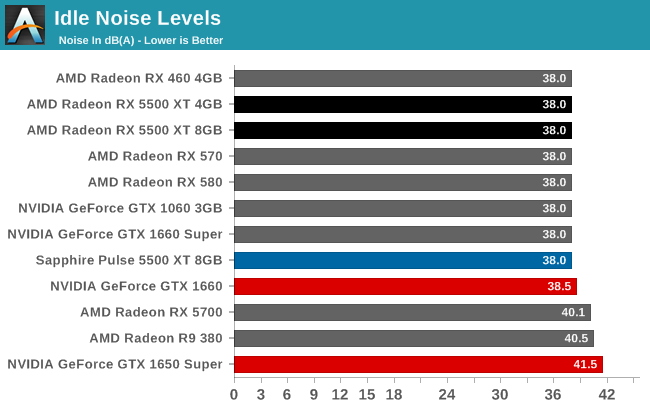
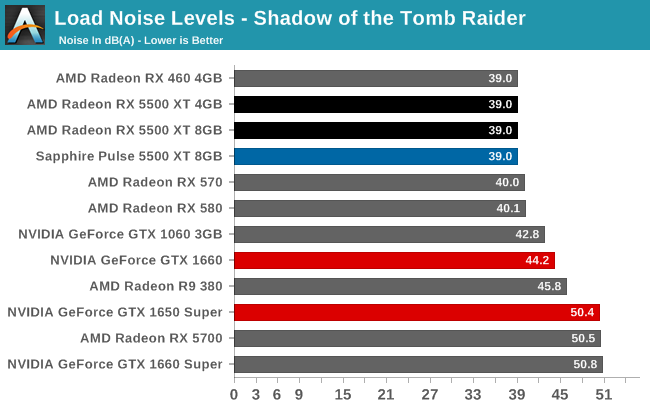
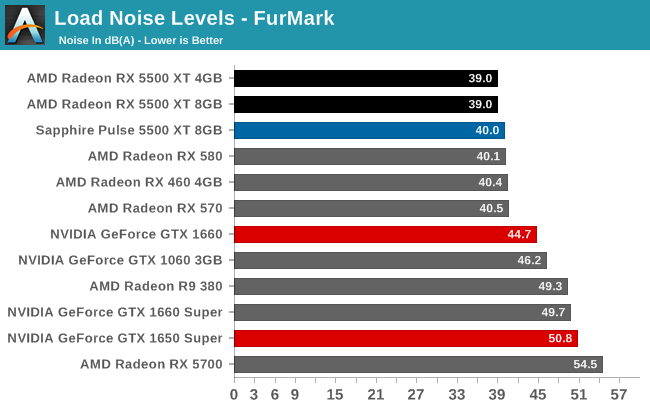
But when we get to noise, this is where Sapphire blows our socks off. Or rather, doesn’t blow our socks off?
The load noise levels I measured here were so low that it required extra effort to properly duplicate the results and isolate noise sources. With a card TDP of 130W, those big 95mm fans end up doing very little work. The PWM and monitoring-enabled fans run at under 800 RPM on gaming workloads, and it’s only when we’re using Sapphire’s higher TDP performance BIOS that the fans crack 1000 RPM.
Sapphire could probably cool a 200W card with this cooler, and I wouldn’t be too surprised to learn that it’s exactly such a card they took it from. But the net result is that while the card is a space hog, it’s a silent space hog. With load noise levels below 40 dB(A) for everything except FurMark, the card is barely louder than the rest of the system. Compared to our GeForce cards, all of which are smaller cards with equally small fans, the difference is extensive. Sapphire may have overbuilt their card, but as a result they’ve struck a great balance between temperatures and cooling performance, and delivering great acoustics in the process.


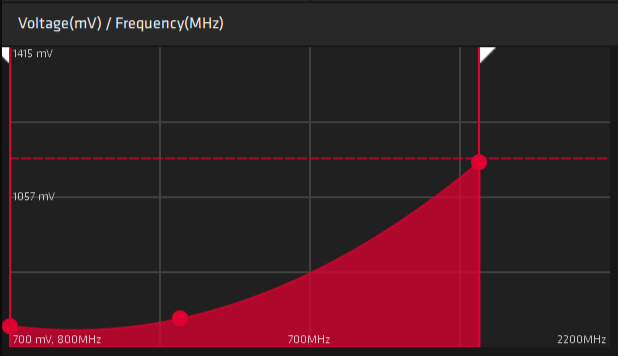








97 Comments
View All Comments
YB1064 - Thursday, December 12, 2019 - link
Poor man's NVidia indeed.flashbacck - Thursday, December 12, 2019 - link
What do you mean by that?Valantar - Thursday, December 12, 2019 - link
Apparently the same performance at the same price with a better encode/decode block and better idle power usage but slightly worse gaming power usage and buggy OC controls equals "poor man's Nvidia". Who knew?assyn - Thursday, December 12, 2019 - link
Actually the Nvenc is better encode/decode because has wider format support and can decode 8K videos, while the AMD only capable of 4K.Valantar - Thursday, December 12, 2019 - link
The 1650 and 1650S have a cut-down NVENC block lacking pretty much every single improvement made with the Turing generation. Not all NVENC is equal.Ryan Smith - Thursday, December 12, 2019 - link
1650S has a full NVENC block. It's based on TU116, not TU117.jgraham11 - Friday, December 13, 2019 - link
Seems like this will be similar to the GCN cards in the past (RX5XX Series), at the beginning its ok, then over the years AMD's fine wine kicks in. Making incremental improvements that improve overall performance with every driver release. Do realize they are still using the GCN instruction set but RDNA is a new architecture, an architecture that will be in both the Xbox and PlayStation systems.WaltC - Saturday, December 21, 2019 - link
I feel as though AMD has hobbled this card. They put the GDDR6 VRAM onboard, effectively doubling more or less the bandwidth of GDDR5, but then they took it all back with the 128-bit bus...;) I think they missed an opportunity here--but I'm not privy to the manufacturing particulars for the product--so maybe not. Anyway, it seems like they might have made the 5500XT a GDDR6 8GBs, 256-bit bus GPU for $279; then made the 5500 with 4GB, and a 128-bit bus for ~$129 or so. The SPs by themselves are sufficiently cut down to the degree that even a 256-bit bus GPU like I've dreamed up here is going to be sludge next to a 5700--or, that should certainly be the case, I would think. The card almost seems "overly hobbled" to my way of thinking. I think that @ 256-bit 5500XT, 8GBs of GDDR6 might've been a smash seller for AMD @ a ~$279 MSRP, leaving the 5700 still clobbering it simply based on the much higher number of SPs. I just see a lot of potential here that seems overlooked--unless they have plans for a 5600XT, maybe, early 1 Quarter 2020....;)WaltC - Sunday, December 22, 2019 - link
Will someone please set me straight on whether this is an 8-lane PCIe card? I'm reading this stuff you-know-where but it doesn't make any sense at all to me. It's claimed that accordingly the 5500XT runs much faster on PCIe4 than PCIe3. Eh?https://www.reddit.com/r/Amd/comments/edo4u8/rx_55...
RX-480/580/590 are all PCIex16 GPUs with 256-bit buses running GDDR5. Is the article linked here factual? thanks--to whomever can answer....;) Doesn't sound probable to me--but if it's true then AMD has hog-tied this card six ways to Sunday--trussed up tighter than a Christmas piglet...;)
WaltC - Sunday, December 22, 2019 - link
OK, I saw the one line in the review I missed first time about "I suspect 8 PCIe lanes"--just very strange--I don't understand this product at all! Perhaps the full incarnation of the GPU is going into the PS5/XBox 2, it's just weird. To have to hobble it that much, the GPU must be very robust.